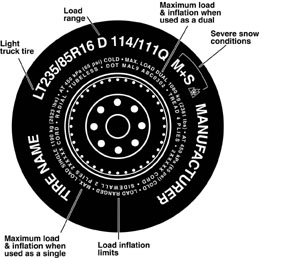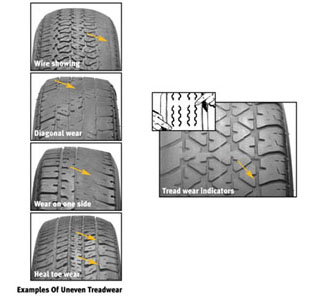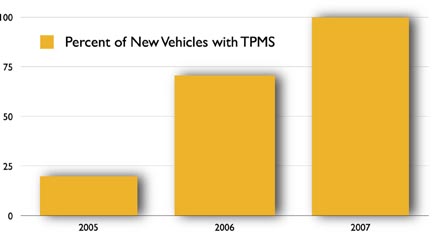Lou’s Tire Advantage
You don't have to shop around or clip coupons. At Lou's Car Care, you get the absolute best service and competitive pricing, guaranteed. We will match or beat competitors pricing on tires! (* For in stock and non-discontinued tires) With the largest selection of brand name tires in town. Why would you go anywhere else? With the purchase of tires at Lou’s you receive:
01Hunter Road Force
Balancing
02Tire Disposal
03Free Lifetime Flat
Repairs
04Free Lifetime Rotations
05Free Alignment Checks
06Free TPMS Calibration to
your vehicle
Tire Learning Center
How to Read the Sidewall of a Tire
Your tire has very useful information molded into the sidewall. It shows the name of the tire, its size, whether it is tubeless or tube type, the maximum load and maximum inflation, the important safety warning and much other information.
Passenger Tires
Shown below is the sidewall of a popular "P-metric," speed-rated auto tire. "P" stands for passenger; "215" represents the width of the tire in millimeters; "65" is the ratio of height to width; "R" means radial; "15" is the nominal rim diameter code; and "95H" is the optional service description that consists of the load index (95) and the speed symbol (H). Some older speed-rated tires may include the speed symbol immediately before the "R" instead of showing a service description.
Typical Passenger Tire

A "B" in place of the "R" means the tire is belted bias construction. A "D" in place of the "R" means diagonal bias construction. "M+S" with the mountain/snowflake symbol is the designation that the tire meets the RMA (Rubber Manufacturers Association) definitions for use in severe snow conditions.
The maximum load is shown in kg (kilograms) and in lbs (pounds), and maximum pressure in kPa (kilopascals) and in psi (pounds per square inch).
The letters "DOT" certify compliance with all applicable safety standards established by the Department of Transportation (DOT).
Adjacent to this is a tire identification or serial number. This serial number is a code with up to 12 digits that are a combination of numbers and letters. The last characters are numbers identifying the week and year of manufacture. (Example: "1501" means fifteenth week of the year 2001.)
The sidewall also shows the type of cord and number of plies in the sidewall and under the tread.
The DOT requires tire manufacturers to grade passenger car tires based on three performance factors: treadwear, traction and temperature resistance.
Typical Light Truck Tire

Tire Care an Safety
Proper Tire Inflation Pressure
With the right amount of inflation pressure, you will achieve optimum tire performance. This means your tires will wear longer, save fuel and help prevent accidents. Unfortunately, a failure to maintain the correct inflation pressures may result in rapid wear and uneven tread wear, improper vehicle handling and excessive heat buildup which may result in tire failure.
How much inflation pressure is required?
If you have purchased your tires from Lou's Car Care, stop by any of our locations and have our tire pros check the pressure on your vehicle's tires. If necessary, we'll add the right amount of air to meet your vehicle's specifications.
If you would like to check it yourself, the correct pressure is specified by the vehicle manufacturer and can be found on the tire placard (or sticker) attached to the vehicle door edge, door post, glove box door or fuel door. Keep in mind that the pressure may be different for the front and rear tires on your particular model car or light truck.
NOTE: Evidence of air loss or repeated underinflation requires tire removal and expert inspection. If you suspect that you have a problem, please visit our service center.
How often should the tire pressure be checked?
Check tire inflation pressure (including the spare) at least once a month and before every long trip. Tires must be checked when they are cold; that is, before they have been run a mile.
If your vehicle doesn't have a placard, check the owner's manual or consult with the vehicle manufacturer, tire manufacturer or our service center for the proper inflation. In addition to the cold tire air pressure, the placard will tell you the maximum vehicle load and the tire size recommended by the vehicle manufacturer.
Can't I tell that the pressure is low by looking at the tire?
 Air pressure enables a tire to support the load, so proper inflation is critical.
Air pressure enables a tire to support the load, so proper inflation is critical.
Unfortunately, as this picture demonstrates, it is very difficult to tell whether radial tires are under-inflated just by looking at the tires.
In the same sense, it's important that you don't over-inflate your tires. The differences are very difficult to see but improper inflation can impact the life of your tires, your vehicle's handling, and your gas mileage.
Remember, if you are checking the tire pressure, it's important to use an accurate tire gauge.
Irregular Tire Wear
We recommend that you inspect your tires on a monthly basis for signs of uneven wear. If the problem isn't corrected, further tire damage will occur. Uneven wear patterns can be caused by the following:
- Improper inflation pressure
- Misalignment
- Improper balance
- Suspension neglect
As you can see from the examples below, if your tire's tread isn't wearing evenly, you may have a problem:

If you suspect that you have a problem, please visit our service center as soon as possible. If the problem is discovered early enough, and we are able to fix the issue, your tires may continue to be used on your vehicle. Keep in mind that uneven wear patterns may indicate that the tire has suffered internal structural damage and should be brought to us immediately for inspection.
Always remove tires from service when they reach a remaining tread depth of two thirty-seconds of an inch (2/32"). If not corrected, wet weather accidents are more likely to happen due to skidding on bald or nearly bald tires. Also, excessively worn tires are more susceptible to damage from road hazards.
 Built-in treadwear indicators, or "wear bars," which look like narrow strips of smooth rubber across the tread, will appear on the tire when that point of wear is reached. When you see these wear bars, the tire is worn out and it's time to replace it.
Built-in treadwear indicators, or "wear bars," which look like narrow strips of smooth rubber across the tread, will appear on the tire when that point of wear is reached. When you see these wear bars, the tire is worn out and it's time to replace it.
Remember to inspect your tires frequently. Look for any stones, bits of glass, metal or other foreign objects wedged in the tread. These may work deeper into the tire, cause air loss and allow moisture into the tire structure, both of which can lead to tire failure.
If any tire continually needs more air, bring it to us and we'll find out why it is leaking. Damage to the tire, wheel or valve may be the problem.
What is a Tire Pressure Monitoring System
In 2000, Congress passed the Transportation Recall Enhancement Accountability and Documentation (TREAD) Act to make tires safer for the motoring public. There are four components to the act – Tire Testing and Safety Standards, Tire Pressure Monitoring Systems, a new Tire Labeling System, and an Early Warning Reporting System.
What is TPMS?
The TREAD Act made it mandatory for automobile manufacturers to include dashboard low-tire-pressure were first required in 10% of new vehicles in 2004, increasing to 100% of new vehicles by 2007.

Why TPMS?
The gradual loss of air, often as the result of poor maintenance or control of tire pressure is the primary cause of tire blowouts – and the cause of many traffic accidents and fatalities. TPMS was specifically developed to deal with this problem.
By continuously taking extremely accurate measurements, monitoring tire inflation pressure, and informing the driver when under inflation is detected, TPMS dramatically improves driving safety. It also reduces automobile accidents and fatalities, maintains your car's performance level, increases fuel efficiency, and extends tread life.
How Does TPMS Work?
Tire Pressure Monitoring Systems (TPMS) include four pressure and temperature sensors, one affixed to each wheel.
 As you can see in the graphic to the right, a TPMS sensor (shown in red) is connected to the valve stem on each wheel of your vehicle.
As you can see in the graphic to the right, a TPMS sensor (shown in red) is connected to the valve stem on each wheel of your vehicle.
Each sensor constantly monitors the current tire inflation based on both temperature and wheel speed, and transmits this information to the vehicles onboard computer.
If the inflation pressure falls below a safe level, TPMS alerts the driver by means of a signal lamp on the dashboard instrument panel.
Unlike other warning lights you may have seen on your dashboard in the past, the TPMS warning lamp should not be ignored and cannot be disabled until the tire pressure has been corrected.